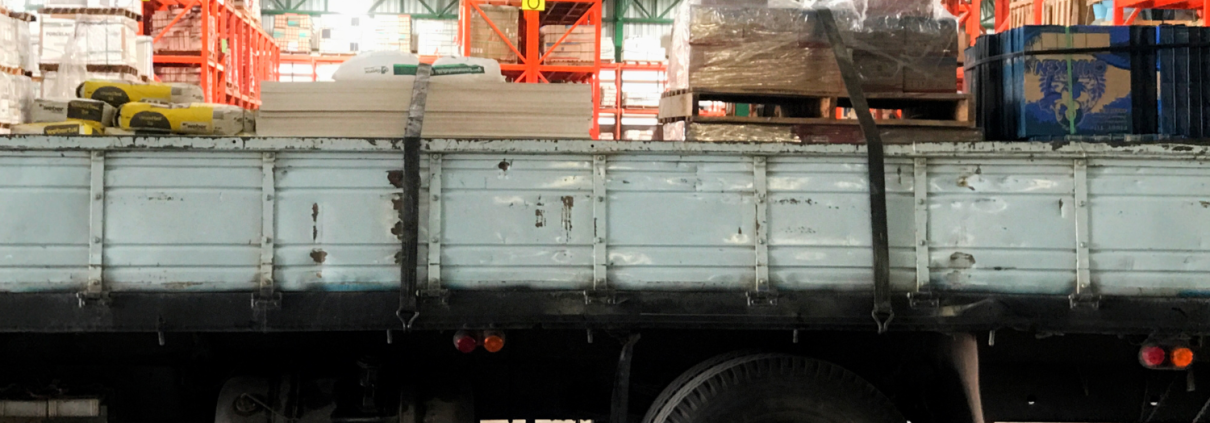
Transporting building materials is a vital part of the supply chain that fuels construction, infrastructure, and economic development across the U.S. From lumber and drywall to steel beams and concrete, these loads are critical to the American economy and way of life, but hauling them requires specific skills, safety awareness, and attention to detail.
If you’re a CDL driver considering or currently hauling building materials, keep reading to find out what you need to know about the job’s demands, advantages, and best practices.
Common Types of Construction and Building Materials Truckers Haul
Building materials can vary greatly in shape, weight, and fragility. To transport them safely and securely, it’s important to understand the unique characteristics and wide range of potential freight.
As a driver, you may be tasked with hauling:
- Lumber and plywood
- Drywall and insulation
- Bricks and masonry products
- Steel beams and rebar
- Cement (in bags or mixers)
- Glass panels or windows
- Roofing materials like shingles or tar
These materials are transported using different equipment depending on the load, including: flatbeds, dry vans, curtain sides, and in some cases, dump trucks or cement mixers. Flatbeds are especially common for oversized or awkwardly shaped materials that need to be tied down and tarped.
Challenges of Transporting Construction and Building Materials
While hauling construction and building materials can be a rewarding niche, it’s also important to understand the challenges that can come with this freight.
1. Load Securement
Securing building materials safely and legally is one of the most critical, and labor-intensive, parts of the job. Improperly secured loads can shift during transit, leading to crashes or violations of FMCSA load securement regulations. You will need to use straps, chains, edge protectors, and tarps.
2. Heavy and Irregular Loads
Building materials aren’t uniform. They can be oversized, oddly shaped, or heavy. Drivers must be confident in weight distribution, axle limits, and how to load/unload without damaging cargo.
3. Jobsite Deliveries
Delivering to construction sites can be more complex than a typical dock. Sites may be muddy, uneven, or lacking clear access points. You’ll need to maneuver carefully, sometimes in tight quarters with heavy equipment nearby.
4. Weather Exposure
Flatbed loads are often exposed to the elements, meaning you may have to tarp in rain, wind, or snow. Weather can also affect unloading times at sites, leading to delays.
5. Physical Demands
Many material-hauling jobs are more hands-on than other types of trucking. You may have to assist with load securement, unloading, or even directing equipment operators on-site.
Benefits of Hauling Construction and Building Materials
While transporting construction and building materials may come with challenges, it also offers several advantages that make it a rewarding and valuable freight for CDL drivers to carry.
Here are a few:
1. Strong Demand
Construction is a year-round industry, and demand for skilled drivers who understand how to handle building materials remains high. Whether residential or commercial, there’s always a need for materials and materials transportation.
2. Competitive Pay
Specialized freight like building materials often offer higher pay, particularly for flatbed drivers. The extra skill, effort, and responsibility involved, such as load securement and jobsite deliveries, make it a valuable niche for drivers.
3. Daytime Hours and Regional Routes
Many building material deliveries are regional or local, with consistent daytime schedules. This is perfect for drivers looking for more home time or set hours.
4. Diverse Skills Development
Hauling building materials sharpens skills beyond basic driving, including load securement, tarping, site navigation, and communication with on-site crews. Gaining experience in these areas makes you more attractive to employers and can open the door to more specialized and higher-paying opportunities.
Safety and Success Tips for Transporting Construction and Building Materials
To thrive in this line of work, preparation and vigilance are key. Here are some tried-and-true tips:
1. Master Load Securement
Be sure to understand FMCSA cargo securement regulations and follow them closely. Use proper tie-down methods, regularly inspect straps and chains, and make sure everything is secure before hitting the road. If you’re unsure, always ask. Mistakes can be costly or dangerous. Learn more about safe, successful load securement here.
2. Invest in Quality Gear
Have your own PPE, gloves, and safety boots. If you’re hauling flatbed, invest in your own tarps, bungee cords, and edge protectors, it can make a big difference in efficiency and job readiness.
3. Plan for Site Conditions
Before arrival, try to gather information about the jobsite, such as its terrain, access roads, and unloading protocols. Use satellite views or apps like Trucker Path to preview the layout.
4. Stay Aware of Your Surroundings
Construction sites are dynamic, with workers, machinery, and ongoing activity. Always watch your mirrors, back in carefully, and never assume someone can see or hear you.
5. Communicate Clearly
Work closely with loaders, crane operators, and site supervisors. If you’re unsure about where to park or unload, ask. Miscommunication can slow the process or lead to accidents.
6. Watch the Weather
Wet or windy weather can turn a tarp job into a dangerous task. Know your limits, and don’t take shortcuts. If weather delays are inevitable, notify dispatch and prioritize safety. Construction also often increases in the summer, which means it’s especially important to stay hydrated, take breaks as needed, and be smart about working in extreme heat or sun exposure.
Transporting building materials can be a challenging but rewarding career path for truck drivers who value hands-on work, skill development, and a key role in the construction supply chain.
Looking for more information on new trends and industry advice? Be sure to check out more posts on our blog and connect with us on social media!





